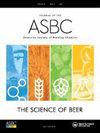Sensory and Chemical Properties of Virginia Hard Cider: Effects of Apple Cultivar Selection and Fermentation Strategy
IF 1.8
4区 农林科学
Q4 BIOTECHNOLOGY & APPLIED MICROBIOLOGY
Journal of the American Society of Brewing Chemists
Pub Date : 2022-05-09
DOI:10.1080/03610470.2022.2057780
引用次数: 4
Abstract
Abstract The U.S. cider market has expanded in recent years, but limited research-based information is available on fermentation management. This study investigates how apple cultivar and yeast inoculation affect the chemical and sensory properties of ciders made in Virginia. Four ciders were produced in triplicate using combinations of two different apple cultivars — Harrison, a cider cultivar and GoldRush, a dessert cultivar — and two fermentation strategies — inoculated with dry active yeast EC1118 or Pied de Cuvé (PdC) ambient fermentation. Ciders were analyzed for alcohol content, free/total SO2, titratable acidity, volatile acidity, malic acid, pH, and residual sugar. Sensory evaluation was conducted using descriptive analysis with trained panelists. Results were analyzed via analysis of variance (ANOVA) and principal component analysis. Apple cultivar and fermentation method resulted in significant differences for chemistry and sensory parameters. Malic acid concentration was greater in the control ciders while concentrations of both residual sugar and volatile acidity were higher in the PdC ciders. The interaction effect of cultivar*fermentation method influenced both malic acid and residual sugar concentrations, where concentration differences between control and ambient ciders were smaller for GoldRush than for Harrison, showing that fermentation style produced different results across cultivars. Volatile acidity produced opposite interaction effects as differences between fermentation styles were larger for GoldRush. For sensory attributes, Harrison ciders produced high intensities for multiple attributes, but also higher variability. Multiple sensory descriptors displayed interaction effects as the fermentation method produced different results in different cultivars. This study demonstrates that increasingly popular practices in the industry can produce significantly different ciders.弗吉尼亚烈性苹果酒的感官和化学特性:苹果品种选择和发酵策略的影响
近年来,美国苹果酒市场不断扩大,但关于发酵管理的研究信息有限。本研究考察了苹果品种和酵母接种对弗吉尼亚苹果汁化学和感官特性的影响。用两种不同的苹果品种(苹果品种Harrison和甜点品种GoldRush)和两种发酵策略(接种干活性酵母EC1118或Pied de cuv (PdC)环境发酵)的组合生产了四种苹果酒,一式三份。分析了苹果酒的酒精含量、游离/总SO2、可滴定酸度、挥发性酸度、苹果酸、pH和残糖。感官评估采用描述性分析与训练有素的小组成员。通过方差分析和主成分分析对结果进行分析。苹果品种和发酵方式对化学和感官参数有显著影响。对照苹果酸浓度较高,而PdC苹果酸残留量和挥发性酸度浓度较高。品种*发酵方式对苹果酸和残糖浓度均有影响,其中GoldRush与环境苹果酒的浓度差异小于Harrison,说明不同品种的发酵方式产生的结果不同。挥发酸产生相反的交互作用,不同发酵方式的差异较大。对于感官属性,哈里森苹果酒产生了高强度的多个属性,但也有更高的可变性。由于发酵方式对不同品种的影响不同,多个感官描述符表现出交互作用。这项研究表明,越来越流行的做法,在行业可以产生显著不同的苹果酒。
本文章由计算机程序翻译,如有差异,请以英文原文为准。
求助全文
约1分钟内获得全文
求助全文
来源期刊

Journal of the American Society of Brewing Chemists
工程技术-生物工程与应用微生物
CiteScore
4.00
自引率
20.00%
发文量
41
审稿时长
3 months
期刊介绍:
The Journal of the American Society of Brewing Chemists publishes scientific papers, review articles, and technical reports pertaining to the chemistry, microbiology, and technology of brewing and distilling, as well as the analytical techniques used in the malting, brewing, and distilling industries.
 求助内容:
求助内容: 应助结果提醒方式:
应助结果提醒方式:


